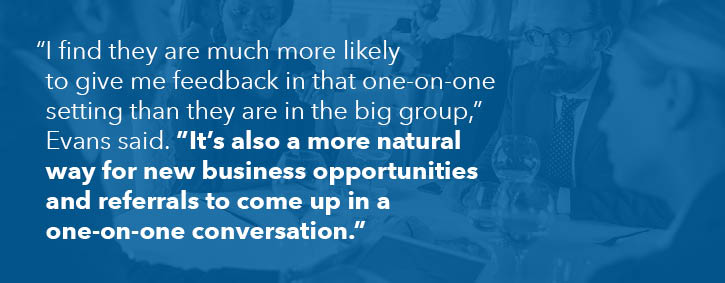Planning & Productivity
As a financial professional, you know how to help clients navigate the best paths to reach their financial goals. But that focus can leave little time for staying on top of shifting trends that can affect your business or getting insight and advice to help keep your practice competitive.
One solution is to establish an advisory board: a group of professionals either outside or inside your profession, who can help you fill in gaps of knowledge, offer insight on new markets and industries, and highlight changing demands of current clients — not to mention act as an important source of business development and client referrals.
The goals, membership and management of advisory boards can be as varied as the financial professionals who host them. Here are examples of how three teams are leveraging advisory boards, and the five steps you can take to create an advisory board of your own.
Growing alongside fellow business owners
Ray Evans of Pegasus Capital Management in Kansas City started his firm’s advisory board 27 years ago, after his father remarked how much the older generation enjoys mentoring younger executives. It was at a time when Evans and many of his colleagues were leaving corporate life and starting up their own firms.
That first advisory board included six friends and fellow business owners. Given their location in Kansas City, the chatter could include Royals baseball or Chiefs football, as well as growth strategies or human resources issues related to building a business.
That original group of six blossomed to 20, and the discussions have become more structured and purposeful. Only half are firm clients; the rest are business leaders in industries important to Evans’ clients and the Kansas City region.

The board meets for 90 minutes quarterly, either at Evans’ office or a country club. They spend about half of the meeting on the investment business, but Evans said he most values getting direct feedback from fellow business owners: “I really want to hear from the tool-and-die guys — how they do what they do, what they think they’re seeing.”
To keep things interesting and build new networks, one meeting each year takes place at what he calls a “rising” local business, an in-the-field seminar that Evans says is a highlight. “This is a business that you're reading a lot about in the paper that is obviously doing great things and is on a growth path,” he said. “And they're usually eager to host that fourth meeting.”
Top tip: Don’t forget to follow up with board members individually.
Evans says he makes sure to have private discussions with each board member. “I find they are much more likely to give me feedback in that one-on-one setting than they are in the big group,” he said. “It’s also a more natural way for new business opportunities and referrals to come up in a one-on-one conversation.”
Seeking allies in the empowerment of women
Heather Ettinger of Luma Wealth in Cleveland recently launched a five-person advisory “council” explicitly not to drum up new business. “I understand why other firms do that, but my mission is to help women adapt to a fast-changing world. And I want to surround myself with great leaders that force me to think differently,” Ettinger says.
Luma’s council is composed of other women working on that same mission, albeit on different tracks. “So, I’m trying to do two things: bring talent to the table that can expand my knowledge about how best to serve women and their families, and … grow as a leader,” she said. “Getting council members from wealth management is not going to get me there. I already have those connections.”
Instead, she sought out women with expertise in impact investing, next-generation and diversity issues, integrative medicine, and mezzanine financing for women business owners. She said she wants the council to challenge her firm’s existing client services and present new ways of thinking that can help her position her firm for faster growth.

Luma’s board meets (virtually, for now) for 90 minutes four times a year, and its members hold two-year terms. Ettinger says she makes it a priority to send meeting materials three weeks in advance and provide specific instructions on the topics for the upcoming discussion.
Top tip: Consider compensating board members.
Aware that professional women are often asked to volunteer their expertise for free, she said her board members receive cash compensation and a donation in their names to their favorite charities. “To me, it’s really important that women are paid,” she added.
Co-learning to make the industry better
As director of RIA Distribution at Capital Group, Eric Grey is keen that his team stays abreast of its clients’ goals and how Capital can help achieve them. That led to the launch of the Capital Group RIA Advisory Board in late 2019. Each member was chosen so that the board would have a range of C-suite experience.
“The RIA industry changes so quickly that we wanted to stay current and be able to get their reactions in real time,” Grey said. “Over the past 20 months, with the pandemic disrupting everything, it’s been absolutely critical to have those voices.”
Board feedback, for example, helped Capital understand how RIAs might incorporate ESG investments into their portfolios so that they can serve clients who want to invest in that sector.”
RIAs are in a fragmented industry and, pandemic aside, their business is in the middle of profound structural shifts, including an aging advisor cohort, record-breaking merger and acquisition activity, and struggles to diversify both their ranks and the clients they advise. The RIA Advisory Board can serve as a gathering spot for independent RIAs to meet and exchange ideas.
The bimonthly board meetings have hosted discussions ranging from COVID disruptions, to the industry and broader economy, to the growing role environmental, social and governance investing is playing in the industry. “We also want to share networks and give them access to learning and individuals that they might not otherwise have access to,” Grey said. “It’s definitely been a case of iron sharpening iron.”
Top tip: Include members outside your circle of relationships.
While some of the board members are long-term partners with Capital Group, some are new to the firm. “We wanted that,” Grey said. “Those that you don’t know well will bring a different and valuable perspective and candor to the conversation.” What all members share, he added, is a set of values and a desire to “contribute beyond their front porch.”
For more information about Capital Group’s RIA Advisory Board, click here.
5 steps to creating an effective advisory board
1. Determine the board’s purpose.
2. Identify board members.
3. Set expectations.
4. Standardize your process.
5. Run a successful board meeting.
To read the full article, become an RIA Insider. You'll also gain complimentary access to news, insights, tools and more.
Already an Insider?
 Eric Grey
Eric Grey